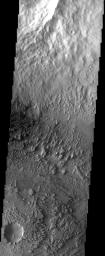
|
Erosion and Wind Deposition
- Click the image above for a larger view
- Full-Res JPEG (1239 x 3025) (593.9 kB)
- Full-Res TIFF (1239 x 3025) (3.4 MB)
Caption:
Released 22 April 2003
Streamlined buttes and mesas are left as remnants of an erosive wind that has carried away sediments and even the rim of a small crater. Two wind directions are apparent in the buttes and mesas that cross each other at 90 degrees. Small dark dunes wind their way between the remnant towers, indicating that the work of the wind is an ongoing process.
Note: this THEMIS visual image has not been radiometrically nor geometrically calibrated for this preliminary release. An empirical correction has been performed to remove instrumental effects. A linear shift has been applied in the cross-track and down-track direction to approximate spacecraft and planetary motion. Fully calibrated and geometrically projected images will be released through the Planetary Data System in accordance with Project policies at a later time.
Image information: VIS instrument. Latitude 5.3, Longitude 350.1 East (9.9 West). 19 meter/pixel resolution.
Background Info:
NASA's Jet Propulsion Laboratory manages the 2001 Mars Odyssey mission for NASA's Office of Space Science, Washington, D.C. The Thermal Emission Imaging System (THEMIS) was developed by Arizona State University, Tempe, in collaboration with Raytheon Santa Barbara Remote Sensing. The THEMIS investigation is led by Dr. Philip Christensen at Arizona State University. Lockheed Martin Astronautics, Denver, is the prime contractor for the Odyssey project, and developed and built the orbiter. Mission operations are conducted jointly from Lockheed Martin and from JPL, a division of the California Institute of Technology in Pasadena.
Cataloging Keywords:
| Name | Value | Additional Values |
|---|---|---|
| Target | Mars | |
| System | ||
| Target Type | Planet | |
| Mission | 2001 Mars Odyssey | |
| Instrument Host | Mars Odyssey | |
| Host Type | Orbiter | |
| Instrument | Thermal Emission Imaging System (THEMIS) | |
| Detector | ||
| Extra Keywords | Crater, Dune, Grayscale, Thermal | |
| Acquisition Date | ||
| Release Date | 2003-04-25 | |
| Date in Caption | 2003-04-22 | |
| Image Credit | NASA/JPL/Arizona State University | |
| Source | photojournal.jpl.nasa.gov/catalog/PIA04478 | |
| Identifier | PIA04478 | |
